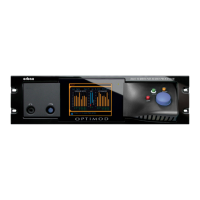OPTIMOD SURROUND PROCESSOR INSTALLATION
2-21
C) Set the 2.0 EXTERNAL AGC control to NO.
If you are using an external AGC before the 8685’s 2.0 processing, you
should restore this setting to Y
ES after the setup procedure is complete.
3. Set the routing between hardware inputs and processing inputs.
L
OCATE to INPUT/OUTPUT > INP. ROUTING. This screen allows you to choose which
hardware inputs feed which processing inputs.
Because each AES3id hardware input receives two audio channels, you
can only route pairs of audio channels. The only exception is C/LFE. The
C/LFE
MAPPING control, located in the INPUT/OUTPUT 4 screen, lets you
swap these two channels.
It is OK to use one hardware input to drive more than one processing in-
put. For example, hardware input 1/2 can drive both the 2.0 processing
and the Lf/Rf inputs to the surround processing.
If your 8685 is equipped with Option 1 (HD-SDI I/O), then the routing
switcher will include both the SDI and AES3id sources and destinations.
Refer to Table 2-2: Routing Switcher Sources and Destinations below.
For an explanation of the F
ALLBACK input, see step 21 on page 2-37.
4. Set the routing between processing outputs and hardware outputs.
L
OCATE to INPUT/OUTPUT > OUT ROUTING and assign processing outputs to the
hardware outputs as desired. Refer to Table 2-2: Routing Switcher Sources and
Destinations below. The sources feeding the outputs are:
• Lf/Rf (left front/right front)
• C/LFE (center/low frequency effects)
The 8685’s audio processing treats C and LFE differently, so it is not pos-
sible to pass the center input through the LFE processing channel and
vice-versa without seriously degrading the sound of the processing. The
input routing switcher allows you to swap the C and LFE channels. This is
appropriate if these are not assigned in the customary way on the AES or
SDI input, which is that “left” carries C and “right” carries LFE. You can
easily detect an accidental swap between dialog and LFE by observing
the 8685’s input level meters.
• Ls/Rs (left surround/right surround —the surround channels in 5.1 and 7.1)
• Lb/Rb (left back/right back —the rear channels in 7.1)
The 8685’s audio processing handles Ls and Lb the same, so it is possible
to swap these without compromising the sound of the processing. How-
ever, the Ls/Rs and Lb/Rb processing channels are not functionally inter-
changeable with the Lf and Rf channels.
• Lst/Rst (left stereo/right stereo — the outputs of the 2.0 processing chains)

